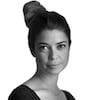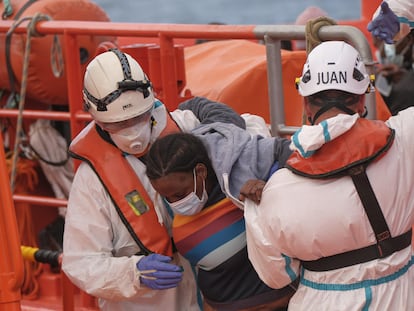Migrants from Mali now account for third-highest number of asylum requests to Spain
While most applicants continue to be Colombian or Venezuelan, 9% were made by Malians, a West African country that has been in conflict since 2013

The more than 4,100 Malians who arrived in Spain’s Canary Islands in 2020 are beginning to be reflected in the official figures of asylum seekers. Up until the start of this year, the citizens from Mali that had arrived in the archipelago were invisible to both Spanish and EU authorities, who considered all arrivals to be economic migrants – not asylum seekers. But according to data from the European Asylum Support Office (EASO), seen by EL PAÍS, Malian citizens have made nearly 1,300 formal requests for asylum in Spain in 2021 – the third-highest number of all nationalities.
Of the 14,914 formalized requests for asylum in Spain, 9% came from applicants from Mali, where a jihadist insurgency has been raging since 2013. Not since then, when the conflict started, have asylum requests from Malians been among the top highest.
Although more resources are still needed and the process has to be sped up, the access to information and the procedure has improved in the Canary IslandsMaría Jesús Vega, spokesperson of the United Nations Refugee Agency
The highest number of asylum requests continue to be made by citizens of Venezuela and Colombia, which account for 21% and 20% of all requests, respectively. But this is the first time in more than two years that the top six countries on the list were not all from Latin America.
The appearance of Malian asylum seekers in the statistics reflects that the system is improving after months of chaos and barriers that blocked access to requesting protection.
Throughout 2020, when around 23,000 migrants arrived in the Canary Islands, potential refugees had great difficulty in requesting international protection. The migrants being held in the Arguineguín port facility in Gran Canaria, for example, had scant help from lawyers while local police lacked training on how to handle asylum requests.
When the migrants were taken to hotels managed by the Red Cross, they also had to wait months to see a lawyer as the charity only had four attorneys for the entire archipelago. And when they were finally able to go to a police station to say they wanted to request asylum, they had to wait more months for the interview that formally begins the process. Only then did their cases reach the official statistics, something that is key to ensuring Spanish and EU authorities recognize the profile and needs of the new arrivals. Improving asylum policies and guaranteeing access to the process is, in theory, a priority of the European Union.
As well as the Canary Islands, Seville, Madrid, Granada and Cádiz also saw sharp rises in the number of asylum requests from Malians
“Although more resources are still needed and the process has to be sped up, the access to information and the procedure have improved in the Canary Islands,” said María Jesús Vega, the spokesperson of the United Nations Refugee Agency (UNHCR). “With the closure of borders [due to the coronavirus pandemic], arrivals at airports and the number of asylum requests fell and that has sped up the resolution of pending requests and the time between when a person says they want to ask for asylum and when their request is formalized.”
In the first four months of 2021, Malians made nearly 1,300 formal requests for asylum – close to the number recorded for all of last year, 1,537. The breakdown by province, provided by the Interior Ministry as of March 31, shows that not all requests were formalized in the Canary Islands. Although the province of Santa Cruz de Tenerife, in Tenerife, recorded the largest rise in asylum requests, there were also sharp rises in Seville, Madrid, Granada and Cádiz, which is where most vulnerable Malians were transferred to as part of the program from the secretary of state for migration to bring at-risk migrants in the Canary Islands to the mainland.
The UNHCR points out that some of the asylum requests recorded in the official figures for 2021 come from citizens of Mali who arrived in mainland Spain a long time ago, but were still waiting for their interview. There has also been a sharp rise in asylum requests from Malians in the North African exclave city of Melilla. Last year, more Malians jumped the border fence separating Melilla from Morocco than any other nationality.
English version by Melissa Kitson.
Tu suscripción se está usando en otro dispositivo
¿Quieres añadir otro usuario a tu suscripción?
Si continúas leyendo en este dispositivo, no se podrá leer en el otro.
FlechaTu suscripción se está usando en otro dispositivo y solo puedes acceder a EL PAÍS desde un dispositivo a la vez.
Si quieres compartir tu cuenta, cambia tu suscripción a la modalidad Premium, así podrás añadir otro usuario. Cada uno accederá con su propia cuenta de email, lo que os permitirá personalizar vuestra experiencia en EL PAÍS.
¿Tienes una suscripción de empresa? Accede aquí para contratar más cuentas.
En el caso de no saber quién está usando tu cuenta, te recomendamos cambiar tu contraseña aquí.
Si decides continuar compartiendo tu cuenta, este mensaje se mostrará en tu dispositivo y en el de la otra persona que está usando tu cuenta de forma indefinida, afectando a tu experiencia de lectura. Puedes consultar aquí los términos y condiciones de la suscripción digital.
More information
Últimas noticias
Most viewed
- Reinhard Genzel, Nobel laureate in physics: ‘One-minute videos will never give you the truth’
- Oona Chaplin: ‘I told James Cameron that I was living in a treehouse and starting a permaculture project with a friend’
- Pablo Escobar’s hippos: A serious environmental problem, 40 years on
- Why we lost the habit of sleeping in two segments and how that changed our sense of time
- Chevy Chase, the beloved comedian who was a monster off camera: ‘Not everyone hated him, just the people who’ve worked with him’











































